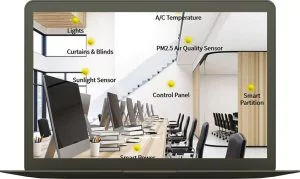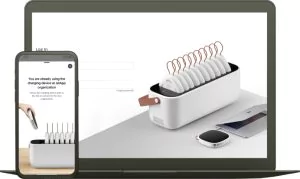In an increasingly paperless world, no one would want to run Dunder Mifflin, a fictional paper sales organization from an American sitcom, The Office. Adopting technology at the workplace has become an extremely important consideration for companies that want to retain their employees as well as grow their business.
The use of the Internet of Things (IoT) devices has become a lasting trend that reshapes the way people approach and manage their work. The global revenue of IoT-based office equipment is predicted to increase from $4.9 billion in 2019 to a whopping $6.4 billion in 2030.
IoT global annual revenue from 2019 to 2030
If you’re thinking about building an IoT-powered device for the workplace, now is the right time to conquer the market. Based on our expertise in IoT solutions development, we at JatApp decided to gather some common use cases, benefits, and challenges of implementing IoT at work, so that you can make a more informed decision. But before we proceed to our discussion, let’s quickly unfold what a smart office is.
What is a smart office?
A smart office refers to the workplace that relies on connected devices and analytics to help employees to work more effectively and productively. Business managers use analytics to make the environment optimal for workers’ well-being as well as streamline different employees’ working processes. Besides, IoT-driven solutions allow for better cooperation between remote and in-office employees as well as between multi-location offices.
Smart offices may have a wide variety of IoT technologies, ranging from automated heating, ventilation, and air conditioning (HVAC) systems to power-bank stations. To better understand the landscape of IoT in the workplace, let’s take a look at common use cases with real-life examples.
A smart office system
4 IoT use cases that are transforming the workplace
The modern workplace is hard to imagine without connected devices. IoT solutions make it easier to manage offices, adopt eco-friendly practices, and ensure security. Common IoT use cases that redefine the concept of today’s workplace include energy efficiency, workplace management, multi-location office management, and restricted control.
Energy efficiency
Smart consumption is one of main reasons why businesses opt for smart office solutions. Cutting down the amount of resources not only helps to protect the planet, but also makes sense from a business perspective. The IoT-driven data allows companies to identify inefficiencies in the system and offer most sustainable measures to minimize their carbon footprint. Moreover, IoT sensors monitor energy consumption in real time, enabling managers to make optimal decisions to keep company’s costs to a minimum.
One of our recent clients, an automated building control system provider, relies on IoT and artificial intelligence (AI) to reduce CO₂ emissions and energy use in the offices by up to 40%. The system scans the room and generates the most sustainable solution for HVAC control. When the indoor conditions change, the technology automatically adjusts the HVAC system to the new environment, contributing to employees’ well-being and comfort. So, if someone continues sweating in the office where such a solution is in place, it would be only because they put a lot of effort in their work.
Dashboard of a building control system
Workplace management
IoT for smart offices enables companies to effectively plan and schedule their meetings. Workers can book necessary equipment or inform about someone’s presence without any verbal confirmation. Smart devices in the workplace also let managers track room availability in real time. IoT sensors send a signal about employees’ presence based on motion and light intensity or energy consumption. In such a way, managers can not only prevent room double-booking, but also collect data related to the device usage.
Our case, a power bank rental platform, makes a great example of IoT in the workplace. Our client provides co-working spaces and organizations with IoT-fueled power banks and charging bases, so that employees could conveniently work wherever they want, without being glued to their desks. A worker registers on the platform via the application to unlock a power bank. When an employee no longer needs the power bank, they can put it into the vacant slot on the charging station.
The power bank rental platform
Multi-location office management
Security cameras have been there for a while now, but the IoT technology has taken them to another level. For instance, now users can see what happens in any remote office in real time. Motion sensors and computer vision-enabled cameras allow them to monitor all the activities as well as keep an account of visitors and deliveries.
IoT devices allow companies to better address various management issues, like broken inventory, lack of supplies, or unexpected visitors. Therefore, managers no longer have to worry about a smart vending machine running out of Snickers bars or a suspicious activity detected at night – the smart device will let them address such issues without the need to be physically present at the office.
Chooch AI is a company that offers smart cameras powered by AI and deep learning algorithms to detect smoke or fire that would otherwise be impossible to notice with the naked eye, especially in poor lighting. The security camera can notify office managers at an early stage by sending images and locations, so that they can take the necessary measures to stop the flame spread.
How Chooch AI works
Restricted access
Today, there are a lot of IoT technologies that help organizations, say, in the banking or military sector, to ensure employee-only access and achieve advanced security, too. IoT biometrics, such as retina, fingerprints, and face recognition, allow for secure authentication. For example, HD cameras inside the building can identify people’s faces for the solution to differentiate employees from visitors. IoT systems that support video streaming can automatically approve or deny access based on face recognition.
Facility managers can be moderators of the system, which is life-saving for those distracted visitors who have forgotten to take off the mask. The technology usually offers managers access to visualized statistics of the streams, which is convenient for tracking what people have entered the building.
Swiftlane uses computer vision and AI to deliver a facial recognition access control system. The solution captures a worker’s face and grants access, if there’s a match with authorized users. It’s also possible to unlock office doors remotely using an application. Such touchless access control has been proved increasingly useful during the times of the global pandemic.
Face recognition from Swiftlane
Benefits of IoT technology in the workplace
For the next few years, IoT-enabled devices are here to stay in the workplace and for a reason. Connected devices bring a number of tangible benefits, such as improved workers’ experience, automated tasks, and predictive maintenance.
Improved workers’ experience
IoT devices are transforming the very nature of work, bringing real-time data regarding employees. Business leaders translate this data into solutions that promote better quality of life and productivity. For example, hot-desking applications can make workers’ lives easier, allowing them to simply login and check whether the desk is available. In such a way, they no longer need to book ahead or show up in the conference room with no vacant place left.
Likewise, IoT-powered sensors can help to check lines in the cafeteria, so workers can go for lunch during the least busy times of the day. These examples illustrate that IoT can help to optimize and better manage the office space, contributing to staff members’ convenience and overall job satisfaction.
Hot desk application functionality
Automated tasks
Today, the market is filled with IoT solutions that help to automate labor-intensive and repetitive tasks. One of the examples of such technologies is applications that track trash bin capacity. Sensors automatically check on bins and alert as soon as they fill up. This eliminates the need to constantly check the bins manually, so that facility managers can concentrate on far more important work tasks.
An example of a full bin capacity notification
By getting rid of mundane tasks, leaders have an opportunity to create an engaging workplace for their employees. They can bring real value to their workforce by offering them more dynamic roles where they can get both creative and enthusiastic.
Predictive maintenance
In the workplace settings, IoT devices are often used for predictive maintenance, especially when it comes to protecting expensive systems, like water pumps and air conditioning. Sensors allow users to identify units that are about to break down, so service providers can proactively address the problem before it actually occurs.
This helps to prevent unnecessary expenses in the long run as well as contribute to employees’ productivity. For example, when a broken water pump needs to be replaced, employees can no longer work in the office, as long as it’s necessary to purge the water. Predictive maintenance systems allow to avoid lost employees’ hours and interruptions in their work.
Difference between reactive, preventive and predictive maintenance
Challenges of using IoT and ways to solve them
Despite aforementioned benefits, many business leaders remain skeptical about adopting IoT in the workplace. One of the main challenges for many companies are high-cost investments associated with this technology. To address this barrier, it’s reasonable to implement small IoT infrastructure at the start. Small, but firm steps towards the future workplace can help organizations to attain their long-term ambitious goals.
In the light of the possibility of the cybersecurity threats, companies’ reluctance to introduce IoT may not appear 100% groundless. Since the devices are connected to the Internet, there’s always a certain risk that they can be a subject to hackers’ attacks.
Therefore, it’s extremely important to think about device security measures at the design stage of development. Moreover, some organizations place IoT tools and absolutely forget about them, disregarding any updates. The device makers should pay special attention to this issue by educating their end-users instead of fearing to lose customers due to increased development costs.
Another possible solution to IoT security challenges is to power a device with a unique identifier. In such a case, the development team can readily monitor its behavior and timely intervene when it’s communicating with an unauthorized device.
Connect your IoT device with today’s workplace
IoT technologies are becoming more sophisticated, being able to practically read our minds. What’s more, this doesn’t seem scary anymore, judging from the stable increase in IoT adoption in the workplace settings. Undeniably, the given technology changes our perception of the work environment and employees’ role in it.
If you’re thinking about building your own IoT solution, there’s never been a better time to start your project. To make sure your ideas are implemented the right way, you may want to seek support from reliable software development companies. JatApp is certainly one of them. In fact, our company has been recognized as one of the top 1,000 B2B outsourcing agencies in the whole world. The IoT-enabled products we helped develop, like a software solution for electric vehicle charging stations and a power bank rental platform, already make a difference in terms of energy consumption and workplace management, attracting thousands of users and dozens of businesses.
Need our help? Please, press this contact us button and we’ll get back to you as early as possible.











